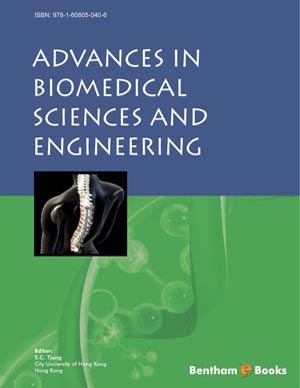Preface
Page: iv-v (2)
Author: Eva Maria Brandtner and John Austin Dangerfield
DOI: 10.2174/9781608057207113010002
List of Contributors
Page: vi-viii (3)
Author: Eva Maria Brandtner and John Austin Dangerfield
DOI: 10.2174/9781608057207113010003
Particular Challenges in Microencapsulation of Insulin-Producing Cells for the Treatment of Diabetes Mellitus
Page: 3-39 (37)
Author:
DOI: 10.2174/9781608057207113010004
PDF Price: $30
Abstract
The ideal treatment for type 1 diabetes mellitus implies minute-to-minute modulations of insulin release according to the continuous variations of blood glucose. This can be accomplished by the transplantation of insulin-producing cells that are located in the pancreatic islets of Langerhans (islets). To avoid the use of potentially toxic immunosuppressive drugs, the cells may be entrapped within semi-permeable microcapsules. While several issues related to this task are similar to those found in other applications of cell microencapsulation, the present chapter emphasizes the challenges that are particular to the development of a bioartificial endocrine pancreas. In contrast to monocellular preparations used in other applications, islets are well organized cell cluster comprising 1500-3000 cells. However, the microcapsule membrane prevents transplanted islets from being re-vascularised. Therefore, oxygen supply depends upon diffusion only. Oxygen has to travel a relatively long distance to reach the cells located in the center of encapsulated islets. Central necrosis occurs, particularly in the largest islets. In contrast, dispersed single islet cells are very resistant to hypoxia but cannot function properly since they require cell-to-cell interactions. Thus, oxygen supply to encapsulated islet cells is crucial. Other issues that are particular to the bioartificial endocrine pancreas involve the number of islets to be transplanted, the rapid response of insulin release to variations of blood glucose levels, the limited supply of allogeneic islets from deceased donors and the implantation site. This chapter addresses all of these issues, as well as promising strategies that are being explored to overcome these hurdles.
Human Trials with Microencapsulated Insulin-Producing Cells: Past, Present and Future
Page: 40-69 (30)
Author: Bernard Tuch, Vijayaganapathy Vaithilingam and Jayne Foster
DOI: 10.2174/9781608057207113010005
PDF Price: $30
Abstract
Microencapsulation of insulin-producing cells is a promising strategy to deliver a cell therapy for treatment of type 1 diabetes without the need for anti-rejection drugs. In this Chapter, we describe our experience in producing microcapsules made of barium alginate, and their application pre-clinically in diabetic rodents and pigs before moving to the clinic in a first-in-man trial with encapsulated human islets. Whilst the use of the microcapsules was safe in the clinical trial, we have learnt from the trial that it is necessary to modify the microcapsule to reduce pericapsular fibrosis, and strategies are being implemented to achieve this. Moreover, the supply of human islets for the clinic is quite limited, and we are now making pancreatic progenitors from pluripotent human embryonic stem cells as a much more reliable and larger source of surrogate cells for encapsulation and transplantation. [Clinical Trial Registration Number ACTRN12609000192280 (Australian and New Zealand Clinical Trials Registry)].
The Diversity of Uses for Cellulose Sulphate Encapsulation
Page: 70-92 (23)
Author: John A. Dangerfield, Brian Salmons, Randolph Corteling, Jean-Pierre Abastado, John Sinden, Walter H. Gunzburg and Eva M. Brandtner
DOI: 10.2174/9781608057207113010006
PDF Price: $30
Abstract
In this chapter we propose sodium cellulose sulphate (SCS) as a prime candidate for clinical application of encapsulated cells and present data for uses of SCS encapsulation for the direct delivery of therapeutic antibodies and advanced approaches for stem cell therapy. We also provide a simple lab protocol allowing researchers to make capsules at the bench without the need for expensive machinery.
Inducible Systems for Cell Therapy and Encapsulation Approaches
Page: 93-101 (9)
Author: Viktoria Ortner, Cornelius Kaspar and Thomas Czerny
DOI: 10.2174/9781608057207113010007
PDF Price: $30
Abstract
Encapsulation of heterologous cells allows the production of therapeutic substances selectively in the required tissues of the patient. Thus high local concentrations help to minimise side effects in other parts of the body. Nevertheless, most substances show small therapeutic windows also at their site of action. Furthermore, the timing of the release has to be adjusted to the requirements of the patient and the treatment. Regulation from the outside is therefore necessary to adjust the expression in the transplanted cells.
Cell Encapsulation Technology: An Alternative Biotechnological Platform for the Treatment of Central Nervous System Diseases
Page: 102-152 (51)
Author: Tania López-Méndez, Ainhoa Murua, José L. Pedraz, Rosa M. Hernández and Gorka Orive
DOI: 10.2174/9781608057207113010008
PDF Price: $30
Abstract
Cell encapsulation technology is based on the immobilization of cells that secrete active therapeutic agents, in structures made from different biomaterials and surrounded by a semipermeable membrane that protects the cells from the host immune response and the mechanical stress. This technology has proven to be a suitable treatment strategy for different kinds of diseases such as diabetes, heart failure, anemia, cancer or central nervous system (CNS) diseases since promising results have been obtained in numerous works that have been carried out in this field. For this last application, cell encapsulation technology presents exceptional features as it allows direct, continuous and long-lasting release of the desired therapeutic product, next to the affected tissue and without crossing the blood-brain-barrier (BBB). Numerous studies have been carried out using this technology, in different animal models of CNS diseases, in which encouraging results have been obtained. Moreover, the rapid developments achieved in recent years, have allowed the application of these strategies in several advanced clinical trials, reflecting the potential of these techniques. However, there are still some features that must be optimized before cell encapsulation technology can be applied in clinical practice. This chapter will focus on the application of cell encapsulation technology in the treatment of CNS diseases, such as epilepsy, different neurodegenerative disorders- Parkinson, Alzheimer, Amyotrophic lateral sclerosis or Huntington-, pathologies caused by traumas or ischemic processes and brain tumors.
Production of Cell-Enclosing Microparticles and Microcapsules Using a Water-Immiscible Fluid Under Laminar Flow and Its Applications in Cell Therapy
Page: 153-177 (25)
Author: Shinji Sakai, Shinji Tanaka, Koei Kawakami and Shigeki Arii
DOI: 10.2174/9781608057207113010009
PDF Price: $30
Abstract
Reduction in the diameter of cell-enclosing spherical vehicles for cell therapy is an important issue, giving benefits such as higher molecular exchangeability between the enclosed cells and the ambient environment, higher mechanical stability and biocompatibility. In this chapter we review our recent studies for the production of cell-enclosing microparticles and microcapsules of about 100-200 m in diameter. They are much smaller than conventional cell-enclosing spherical vehicles, which are typically between 300 and 1,000 m in diameter. We prepare these small vehicles using droplet breakup through jetting in a water-immiscible liquid stream under laminar flow. Factors for controlling the size of droplets and methods for obtaining gelled vehicles are also described. In addition, we demonstrate the feasibility of these small vehicles for cell therapy by showing the results obtained after implanting the vehicles enclosing cells expressing a cancer-prodrug-converting-enzyme into a mouse with a subcutaneously formed tumor.
Index
Page: 178-184 (7)
Author: Eva Maria Brandtner and John Austin Dangerfield
DOI: 10.2174/9781608057207113010010
Introduction
Bioencapsulation (or microencapsulation) of cells and their implantation into a body of immunoprotected cells allows researchers to revive a missing or defective function in the cells. Microencapsulated cells have reached the clinic where they have been shown to be safe and efficacious in numerous clinical trials. Cell types that have been encapsulated for therapeutic purposes include hybridomas, islet cells, "platform" cell lines e.g. HEK293 and CHO cells as well as an increasing focus on the encapsulation of stem cells. This e-book explains the different methods used for achieving cell bioencapsulation based on different polymers e.g. alginate, cellulose sulphate and agarose. Other chapters in this book subsequently describe the use of cell encapsulation in cancer therapy to improve on existing chemotherapies by reducing doses and thus side effects while increasing efficacy for long term in vivo production of (i) tumoricidal or virus neutralising antibodies, (ii) insulin to achieve a self regulating treatment for diabetes and (iii) neuron nurturing factors to treat CNS diseases such as epilepsy, disorders like Parkinson's disease, Alzheimer, Amyotrophic lateral sclerosis, Huntington's disease and pathologies caused by trauma and/or ischemic processes. The book also includes a chapter reviewing the genetic engineering of cells to allow controlled production of biotherapeutics from encapsulated cells. This is a unique and timely book which brings together contributions from some of the leading researchers in the field of cell encapsulation. Interested readers are provided an overview of the exciting developments and clinical experiences of researchers with cell bioencapsulation.

















